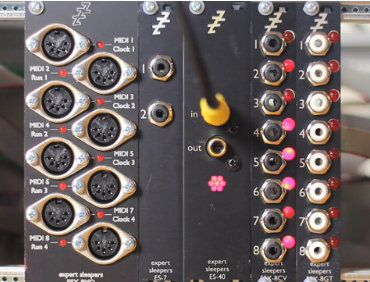
These are the Eurorack modules described in a previous post, which make possible a fascinating hybrid of computer and voltage-based music synthesis at relatively low cost, if you have the patience and fortitude to get them to work.
The concept is that pitch, gate, clock, LFOs, and MIDI data can all be transmitted to a modular synth through a single SP/DIF (digital audio) cable coming from your sound card. Audio is itself a form of voltage and can be sliced and diced into smaller amounts to drive hardware; Expert Sleepers inventor Andrew Ostler has quite cleverly made all these signal distributions. As he points out, audio-based signals are "sample accurate," as opposed to USB or 5-pin MIDI, which are subject to micro-delays and "jitter," thus making it possible to keep several instruments in tighter sync than with normal MIDI outputs from your Digital Audio Workstation.
In practice, the routing of the audio to maximize efficiency in all these channels is perversely complicated, and changes constantly with new revisions to operating systems, DAWs, the equipment, and the "Silent Way" plugin software that makes all this work.
One source of confusion is a design problem: the varied use of the sequence 1-2-3-4-5-etc:
You have expansion headers 1, 2, 3, 4, 5 (or more), depending on the unit. These headers are sometimes called slots and refer to physical (10 pin) connectors on the back of a module.
There are also output ports on the front of a module, numbered 1, 2, 3, 4, etc.
Within the DAW, you have stereo channel pairs 1/2, 3/4, 5/6, 7/8, with channels sometimes referred to by a single number.
The soundcard also has analog and digital channels, numbered 1, 2, 3, etc. Stereo pairs 7/8 correspond to the soundcard's ADAT channels 7/8 (which may be identified in Ableton as channels 17-18).
You have Gates 1, 2, 3, 4, 5, 6, 7, and 8 on an expansion unit. A "gate" could refer to a synthesizer gate signal or it could refer to the port number on the expander.
You have Inputs 1, 2, 3, 4, and 5 on the ES-4 Controller software. I think these refer to the above-mentioned stereo channels but within the Input section you have menus for each Input with the numbers 1, 2, 3, 4, 5, 6, 7, and 8.
You have Inputs 1, 2, 3, 4, 5, 6, 7, and 8 on the ESX-8CV Combiner software and menus giving you a choice for each input of 1, 2, 3, 4, 5, 6, 7, 8, 9, and 10.
You have Output controls 1, 2, 3, 4, and 5 on ES-4 Controller software. I forget what these are for, and why there are five if a module has 5-8 output ports and 5-6 expansion slots.
The Silent Way Voice Controller has controls on its interface that correspond to output ports 1, 2, 3, 4, 5 on the old, discontinued ES-4 hardware, and "hidden" output controls numbered 1, 2, 3, 4, 5, and 6.
And of course you have MIDI channels 1, 2, 3, etc (up to 16)
Small wonder constant confusion occurs on the forum threads regarding which of the above 1s, 2s, 3s, etc people are talking about and what they think they mean. (Couldn't something have been called A, B, C, etc?) Or whether they are speaking of an output, slot, header, or port. Some users are helpful and patient, others adopt a "of course, you don't know this?" tone. Which is insane.
